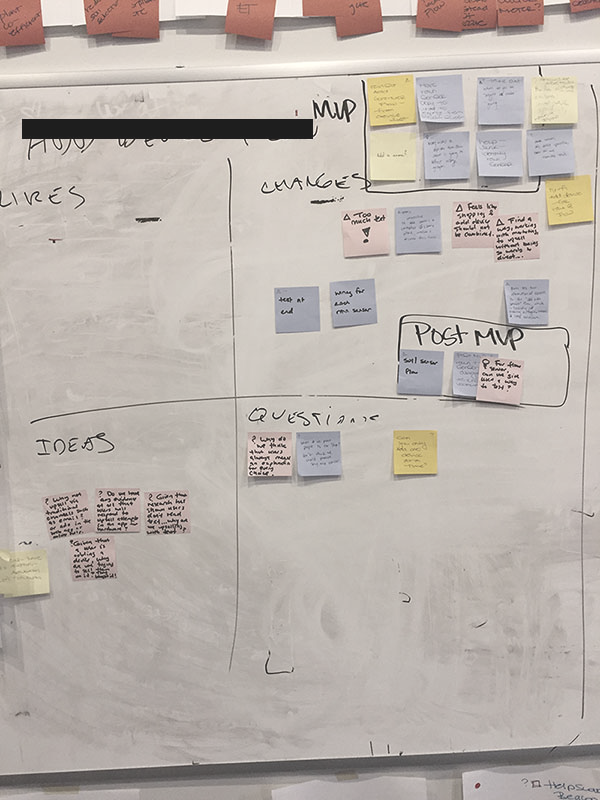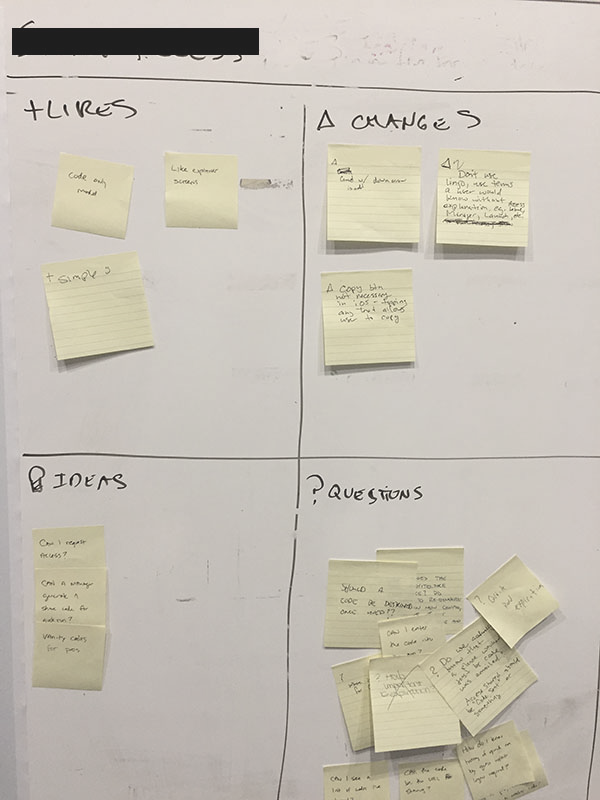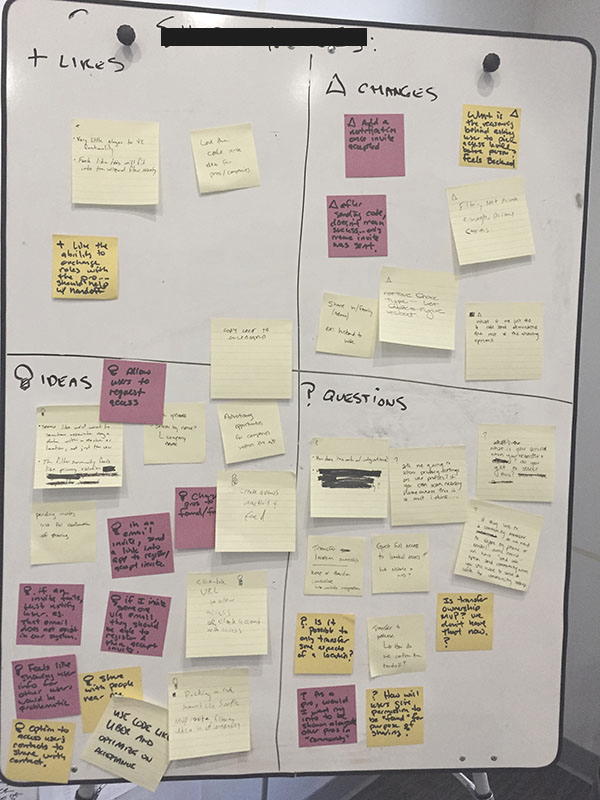Overview
This post outlines a great technique for conducting an efficient Design review meeting. I’ve leveraged this approach in startup and corporate cultures with C-Suite participants. In all situations, people have thanked me for the structured and collaborative approach.
This approach is not exclusive to the Product Design space and can be used to review any idea, process or concept you can think of. If you are facilitating, pitching, presenting or participating in a group review of any kind of content you may benefit from reading this post.
Quick shout out to Product and Technology leader Keren Nimmo for sharing this technique with me years ago.
Traditional design review example. The round-table discussion.
Before getting in to the approach, let’s chat a little about traditional team reviews. In the design space, you’ll most likely find recurring team meetings where various cross-functional team leads all meet to review a new app design or design change.
The format you’ll see most of the time is a “round table discussion” which means anyone speaks up when they have something to say during the review. Participants may include multiple decision makers or maybe the decision maker isn’t present. The duration of the meeting is usually limited to 1hr at best. The lead designer will be facilitating the review and attempting to gather feedback on the design while it’s discussed.
The goal of the meeting is to generate a shared understanding of the design, identify challenges, opportunities and questions from the team. There also might be a goal of getting a final approval on the design.
This approach seems like a good idea, or does it? If your presentation skills are light and or you don’t feel like you have the confidence to guide the discussion you could be in trouble.
Challenges with the traditional format.
Have you ever presented a design or idea and within 5 minutes of kicking off the presentation a team member makes a comment like “from an engineering standpoint this just can’t be done” which led to more conversation and maybe derailed your entire agenda, including completing the actual review itself. Maybe if you had been able to complete the review the team member would have found their comment was unnecessary and accounted for had they waited a few minutes more. Maybe you left that meeting without the information you needed to move forward. Sound familiar?
I’m not saying the team member’s comment isn’t important. It’s crucial that information like that gets captured and the person citing the comment is rewarded for their knowledge. It’s even more important to thoroughly understand any problems before moving forward with more design work.
Here are some of the challenges I encountered when conducting team design reviews using the traditional “round table discussion” format:
- Participating in round-table discussion before completing the review can be wasteful. In many cases completing the review will answer questions and invalidate comments made.
- Important discussions begin, but due to the open format it’s tough to capture all the feedback and truly understand the things that matter the most.
- Highly Extroverted or “Bully” participants may keep other team members from being heard, thus limiting the knowledge in the room and putting the design at risk.
- Introverted presenters or participants may have important comments but may not have the confidence to assert themselves.
If you’re a product designer with at least 2 years under your belt, I’m sure you’ve witnessed these challenges first hand.
Let’s try something different. Enter the “Feedback Workshop”.
Ok let’s take a look at the approach I’ve been using to bring structure to the round table discussion and solve for the challenges mentioned above when reviewing designs or ideas. For the purposes of this post I’ll use the term “Feedback Workshop” to help differentiate this approach from the traditional “Design review meeting”.
Feedback workshop goals:
- Allow a full review of the design or idea before cultivating discussion
- Create a “safe space” where all communication is welcome and feedback is captured from all participants
- Give all participants a chance to speak
- Reveal patterns in thinking and group consensus
- Identify the basics questions, challenges, likes and ideas
- Support remote participation
What you’ll need to conduct the workshop
Location:
Find a comfortable meeting room with an open wall or whiteboard. For best results, conduct this meeting in-person. If some or all of your participants are distributed you can conduct this meeting remotely using a combination of screen sharing and collaboration tools like Mural, Realtime Board or even Slack.
Participants:
Perfect world, invite all of the people who have impact on the direction of the design. If people who have decision making authority over your design don’t attend the meeting they will have missed out on hearing the groups feedback and you risk having to repeat your efforts. If the key “Decider” can’t be present find their next in command and educate them thoroughly on the value of the Feedback Workshop agenda and its findings. That way they can communicate that to their leadership when the time comes.
Time:
The minimum amount of time needed for this approach is 1 hour. Scheduling 1.5 hrs will provide more time for group discussion. The number of people you include in the meeting will directly impact the amount of time it takes to complete the review. Try and keep the group under 7 people if possible if you want to complete the meeting in an hour. This is a great approach for a large crowd with 15–20+ participants but you’ll need to add time to complete the discussion. Worst case scenario for a large crowd and 1 hour is you capture segmented feedback from everyone but you may need to follow up with certain individuals to elaborate on their feedback.
Supplies:
You’re going to need a stack of post-its and a pen for each participant. That’s it. If your meeting room doesn’t have a big whiteboard pickup some butcher paper and tape it to the wall. Another replacement for the whiteboard is a Post-it Super stick easle pad, the larger the better.
Feedback Matrix:
A couple min before the meeting get the “Feedback Matrix” diagram, shown below, up on the wall in the meeting room. You’ll need one of these diagrams for each separate idea or design concept. This diagram will hold the feedback post-its from your team.
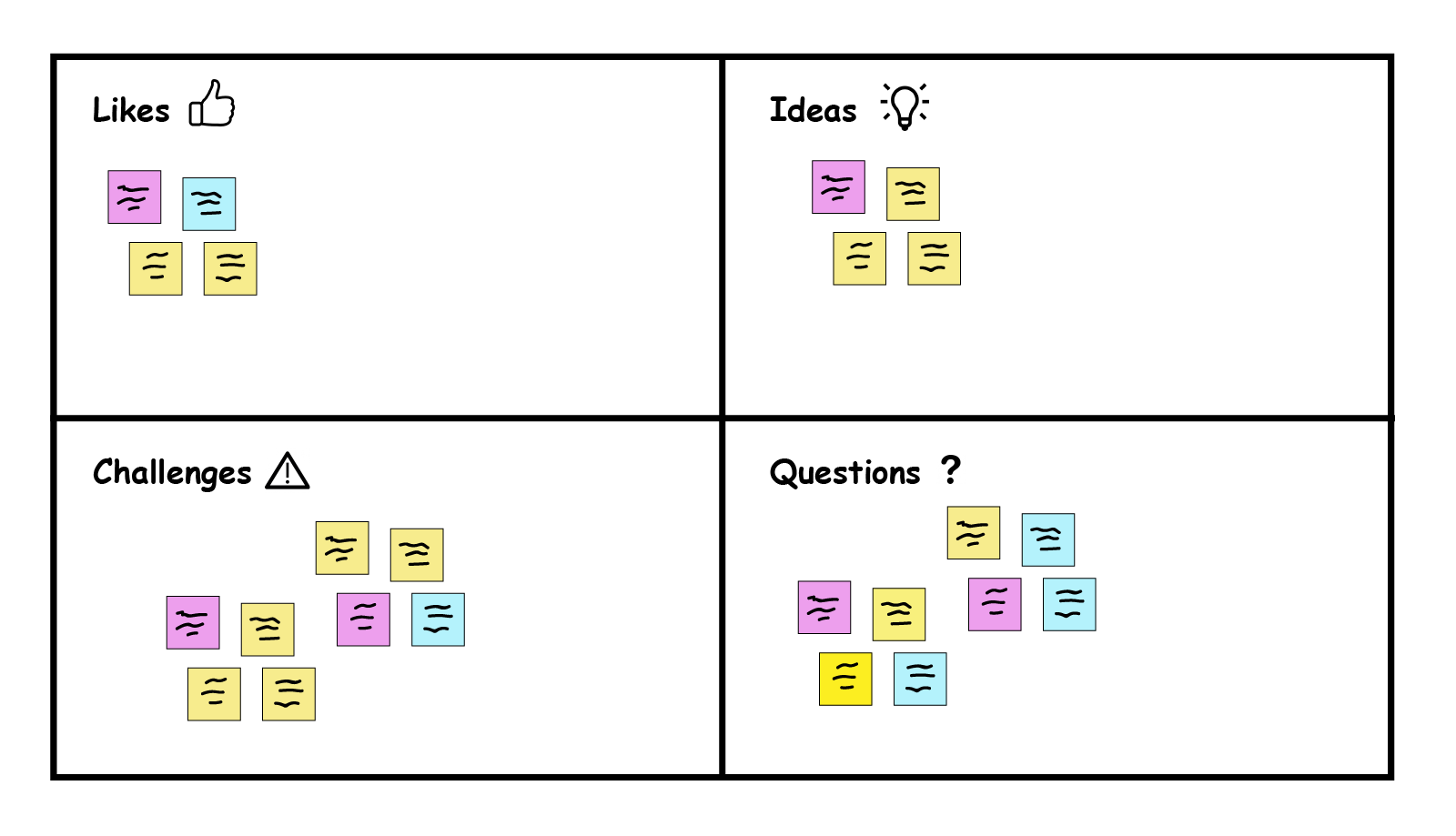
The Feedback Matrix is a simple way way of segmenting feedback into some predefined categories. Providing your participants with predefined categories can inspire different types of feedback and help keep everyone’s comments organized.
Let’s take a quick look at the categories I’m using:
- Likes: Was there anything you liked about the design?
- Challenges: Is any part of the design not feasible?
- Questions: Do you have any questions regarding the design? Are you completely lost?
- Ideas: Do you have any ideas on how to make the design better? Changes?
If you’re dealing with a big team you’ll need more room. If you have a large group or you’re just working with an empty wall and no paper you can use blue masking tape to create the diagram.
How it works
Here’s a quick overview of the approach:
- Each participant is given a stack of post-its and a pen.
- The presenter will conduct a brief and hopefully un-interrupted review of the design while each participant is silently writing their feedback on post-its. Post-its should include the participant initials, the type of feedback from the matrix i.e. Ideas, Likes, Questions and Challenges.
- After the review is complete the participants place their post-its on the wall in each Matrix category.
- The presenter or facilitator quickly starts reviewing each post-it calling on author to speak to the feedback for a quick 1–2m max. The presenter clusters quickly in real-time during the review avoiding belaboring points. This process is fast, fast, fast. You’ll know you’ve done a great job when conversation is buzzing from all seats at the table.
Once the shared brainpower of the team has been fully exposed through a collaborative exercise it’s time to determine next steps. Next steps may require additional discussion depending on the complexity of feedback and on if the decider was present. In those cases, entering the feedback into a spreadsheet may be helpful.
At this point, you should have complete and total permission to bask in the fact that you are a rock star at cultivating collaboration.
Here are some photos of the Feedback Matrix in action:
Sample agenda
Here’s a sample agenda using 1.5 hours of time to collect feedback from 5–7 people on a design that can be reviewed in 10–15m without interruption. For best results, educate your group on the agenda long before the workshop. Use this time to try and identify and solve for any friction from the participants before actually conducting the exercise.
Overview — 5m: Briefly explain the workshop agenda and answer any quick questions.
Background — 10m: Review the background data supporting the design or new idea. Perfect world, talk about your user, value of design to the user, business value and success KPIs.
Conduct the design review — 15m: Presenters begin the review while participants capture segmented feedback on post-its
Feedback lighting review and clustering — 30m: Presenter facilitates lighting reviews of the themes from the post-its. Fast, fast, fast.
Prioritization & next steps — 30m: The presenter guides the decider or decider’s proxy towards a decision on next steps.
Retro — 15m (Optional): If this is your first time using this process with your team consider conducting a quick retro on the workshop. Draw the below image on the whiteboard, a smile for what went well, a flat facial expression for things that participants were unsure of and a frown for things we could have done better in the meeting.
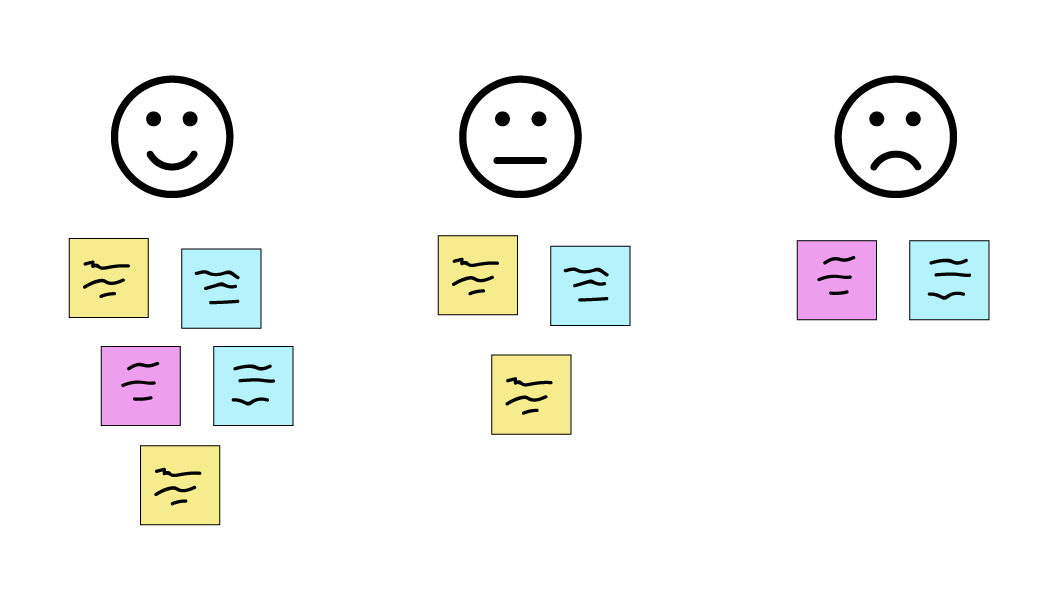
In closing. Long-term rewards.
While operating as a Lead UX Designer in one of my past roles, our team noticed a pattern of combative behavior in our reviews that would end up derailing the meeting before a review of the design work could be completed. All of the meeting participants were working against an aggressive deadline and tensions were high. In an attempt to resolve this toxic pattern, we decided to make the Feedback Workshop policy for all review meetings.
After leveraging the Feedback workshops for a few weeks the communication during meetings improved dramatically because people were no longer competing to have their voices heard. In general, this workshop agenda helped heal what had become a very challenging environment to discuss design in. After a while, we didn’t need the Feedback Workshop to review designs. Participants just carried themselves with empathy for the presenter and the group as a whole.
If you’re encountering challenges while conducting design reviews I encourage you to try this approach. If you do try it or have questions or comments please contact me on Linkedin. I’d love to hear how it went. Riff on this workshop. If you make a change or an improvement I’d love to hear about it.


